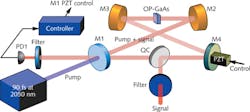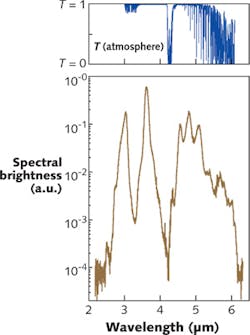NICK LEINDECKER and KONSTANTIN VODOPYANOV
Optical parametric oscillators (OPOs) have long been recognized as a versatile means of producing optical output in important spectral regions unreachable by laser sources. The mid-IR is one such region, rich in spectroscopic information but underpopulated by convenient laser lines. Over the last few years, our group has investigated a special class of doubly resonant OPOs for broadband mid-IR generation.
In a typical OPO, a strong laser pumps the second-order nonlinear susceptibility of a suitable optical material. When combined with an appropriate resonator for optical feedback, oscillation is established at one or more longer wavelengths. The oscillation wavelength is often tuned by adjusting the parameters of the resonator or nonlinear material.
With their broad tunability and substantial output power, OPOs are used extensively for mid-IR spectroscopy. Quantum-cascade lasers (QCLs) now offer a tantalizing alternative, but the restricted tunability of individual devices is still a limit for very broadband measurements. On the other hand, while an OPO may be tuned over a wide spectral range, it is challenging to do so in a precise and continuous fashion.
Doubly resonant, degenerate OPOs
In contrast, we have developed an instantaneously broadband OPO system. It is especially suitable for parallel, high-resolution spectroscopy based on the principle of Fourier transform IR spectrometry.1 The OPO is designed to operate doubly resonant for low pump threshold (less than 10 mW) and is locked near degeneracy where the center wavelength of the output is twice that of the pump, and the acceptance bandwidth of the nonlinear process is very broad. When coupled with a low-dispersion resonator, we achieve extremely broad output bandwidth, with no need (or knob) for wavelength tuning.
Key to enabling these designs has been the commercialization of stable modelocked ultrafast fiber lasers in the near-IR (NIR). When used to synchronously pump our systems, the "comb" of modes of the NIR pump laser is rigorously translated into the mid-IR by phase- and frequency-locked downconversion, with extensive spectral broadening, a characteristic of doubly resonant degenerate OPOs.2
So far, we have demonstrated broadband mid-IR generation in a number of systems using both periodically poled lithium niobate (PPLN) and orientation-patterned gallium arsenide (OP-GaAs) as the nonlinear optical material, with pump sources including erbium-fiber (1.5 μm) thulium-fiber (2.05 μm) and Cr:ZnSe (2.45 μm) modelocked lasers.3-5 In our most recent system (see Fig. 1), the pump laser is a Tm-fiber oscillator-amplifier system provided by IMRA America (Ann Arbor, MI) with 600 mW average power at a center wavelength of 2.05 μm. It produces pulses with duration of 93 fs at a repetition rate of 75 MHz. The OPO resonator is a 4-m-long ring cavity that is matched in length to the pump repetition rate. The intracavity optics comprise a flat dielectric mirror m1 with high transmission for the pump and high reflectivity in the 3–6 μm range, and several gold-coated mirrors with high mid-IR reflectance.
OP-GaAs crystal provides gain
Broadband gain centered at 4.1 μm is provided by a 0.5-mm-long quasi-phase-matched (QPM) OP-GaAs crystal, grown at BAE Systems (Nashua, NH) by a combination of molecular-beam epitaxy and hydride vapor-phase epitaxy, resulting in a QPM "film" thickness of greater than 1 mm. The samples have a usable aperture of 1 × 4 mm. The QPM period was 60.5 μm, which amounts to only eight domain reversal periods over the full length of the 0.5 mm crystal. The crystal was cut and polished for operation at Brewster's angle (73°) and polarizations of all interacting waves were parallel to the <111> direction in GaAs. Yttrium aluminum garnet (YAG) or calcium fluoride (CaF2) with negative group velocity dispersion (GVD, d2k/dω2) at 4.1 μm is inserted inside the cavity at near Brewster's angle, partly compensating the positive GVD of GaAs. Output is taken as Fresnel reflection from this plate.
Double resonance imposes strict phase constraints on the resonator lengths at which the OPO will oscillate. Typically, as we scan the round-trip cavity length, we observe several peaks in the output separated by the pump wavelength. Near threshold (20 mW pump power), oscillation occurs at a single length. As the pump power is increased, we observe oscillation at adjacent length detunings, with about 20 peaks at 600 mW of pump power. The output spectrum is found to vary with cavity length due to the interplay of additional resonator phase and uncompensated dispersion. However, when locked at the optimal resonant length, the spectrum is stable and exhibits extremely broad bandwidth of 2.6–6.1 μm (see Fig. 2). We have outcoupled up to 40 mW from this system using the Fresnel reflections from the dispersion compensating plate.Absorption spectroscopy
The resonator is enclosed in a plastic box to permit purging with dry nitrogen. Otherwise, strong effects from intracavity absorption and dispersion due to atmospheric CO2 and H2O appear in the output spectrum. By introducing trace gases into the OPO resonator, we were able to make sensitive measurements of their absorption spectra through their effect on the OPO spectrum. Fig. 3 shows the absorption spectrum of methane gas near 3.3 μm.These results demonstrate that degenerate synchronously pumped OPOs show great promise for achieving ultrabroadband outputs in the mid-IR. Our degenerate GaAs-based OPO pumped by a Tm-fiber laser offers a more-than-octave-wide output from 2.6 to 6.1 μm—a range where OH, CH, CO, and NH chemical bonds show their strongest vibrational signatures. Proper intracavity dispersion management is essential for achieving such wide bandwidths. In addition to the broad frequency coverage, the low pump power required to reach OPO threshold and the phaselocking of the signal/idler to the pump render this system a potentially ideal source for precision frequency-comb spectroscopy in the mid-IR.
ACKNOWLEDGMENTS
The authors gratefully acknowledge assistance from Alireza Marandi and Magnus Hakkestad, and support from IMRA America, BAE Systems, the US Office of Naval Research, NASA, the Air Force Office of Scientific Research, Agilent Technologies, Stanford Medical School, Stanford Woods Institute, and Sanofi Aventis.
REFERENCES
1. F. Keilmann et al., Opt. Lett., 29, 1542 (2004).
2. A. Marandi et al., Opt. Expr., 20, 7255 (2012).
3. N. Leindecker et al., Opt. Expr., 19, 6296 (2011).
4. N. Leindecker et al., Opt. Expr., 20, 7047 (2012).
5. K. L. Vodopyanov et al., Opt. Lett., 36, 2275 (2011).
Nick Leindecker is a graduate student researcher and Konstantin Vodopyanov is a senior research scientist at the E.L. Ginzton Laboratory, Stanford University, Palo Alto, CA; e-mail: [email protected]; www.stanford.edu/group/ginzton/.


